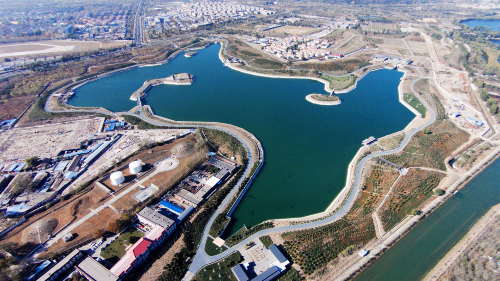|
 |
|
A BIRD'S EYE VIEW: Water from the south will flow into a reservoir near the Tuancheng Lake of Beijing's Summer Palace (XING GUANGLI) |
On December 12, 2014, over 1,400 km of canal and pipeline began carrying water from the Yangtze to the north. Completion of the scheme has been a major victory for the whole project.
President Xi Jinping sent his congratulations to workers and people who have made contributions to the middle route project. He said the success has come through ceaseless effort by hundreds of thousands of people.
Beijing's neighboring province Hebei will also benefit from this project with the supply of more than 3 billion cubic meters of water annually to the province.
"It will alleviate the water shortage in Hebei and help promote sustainable development in the local society and economy," said Zhang Qingwei, Governor of Hebei Province.
A thirsty city
Beijing needs at least 3.6 billion cubic meters of water a year to supply its 20 million residents and to keep local businesses running, but its own water supply was only 2.1 billion cubic meters annually in the past decade.
"The city is facing a severe water crisis," said Xu Xinyi, a water conservancy specialist with Beijing Normal University. "It's like five people stuffed into a room designed for two."
The gap in Beijing's water supply is filled by ground water and water diverted from nearby provinces.
As a result of over-exploitation, Beijing's underground water level has declined by 12.8 meters from its 1998 levels. "The chain reaction has included land subsidence and vegetation damage," said Zhang Tong, Deputy President of Beijing Institute of Water. "A strong gale this summer felled more than 5,000 trees."
Pumping Yangtze water is an effective way to ease Beijing's water crisis. "About half of the water Beijingers consume used to come from underground," said Zhang. "With Yangtze water diverted to Beijing, underground water will make up only 30 percent of total consumption."
This, Zhang said, will ease the pressure on Beijing's environment and prevent underground water levels from dropping too fast.
In Beijing, more than 60 percent of the annual water consumption comes from underground water. The other 40 percent comes from rivers and reservoirs. Underground water will continue to supply 50 percent of Beijing's water when the diverted water arrives in the city.
The level of the water table is around 24.5 meters and is 12.83 meters lower than in 1998. The volume of water in the water table has decreased by 6.57 billion cubic meters, according to the Beijing Water Authority.
The Yangtze water will make up a third of Beijing's total supply and will hopefully narrow the huge gap between its annual water demand and supply. With Yangtze water piped in, Beijing will have 150 cubic meters per person, an increase of 50 percent, according to figures provided by the Beijing Water Authority.
Moving for the project
Zhao Qingxian never thought he would have to move his whole family in 2009.
Zhao used to run a restaurant in Liujialou Village, Nanyang, Henan Province, which is located right at the bank of Danjiangkou Reservoir. The business was very good and Zhao could make half a million yuan from the restaurant each year.
| 